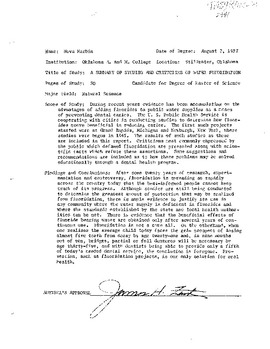| dc.contributor.advisor | Zant, James H. | |
| dc.contributor.author | Harbin, Neva Maxine | |
| dc.date.accessioned | 2018-07-17T16:24:45Z | |
| dc.date.available | 2018-07-17T16:24:45Z | |
| dc.date.issued | 1957-08 | |
| dc.identifier.uri | https://hdl.handle.net/11244/301251 | |
| dc.description.abstract | Scope of Study: During recent years evidence has been accumulating on the advantages of adding fluorides to public water supplies as a means of preventing dental caries. The U. S. Public Health Service is cooperating with cities in conducting studies to determine how fluorides prove beneficial in reducing caries. The first such projects started were at Grand Rapids, Michigan and Newburgh, New York, where studies were begun in 1945. The results of such studies as these are included in this report. Criticisms most commonly expressed by the public which defamed fluoridation are presented along with scientific facts which refute these assertions. Some suggestions and recommendations are included as to how these problems may be solved educationally through a dental health program. | |
| dc.description.abstract | Findings and Conclusions: After some twenty years of research, experimentation and controversy, fluoridation is spreading so rapidly across the country today that the best-informed people cannot keep track of its progress. Although studies are still being conducted to determine the greatest amount of protection that may be realized from fluoridation, there is ample evidence to justify its use in any community where the water supply is deficient in fluorides and where the standards established by the state and local health authorities can be met. There is evidence that the beneficial effects of fluoride bearing water are obtained only after several years of continuous use. Fluoridation is not a cure all. On the other hand, when one realizes the average child today faces the grim. prospect of losing almost five teeth from decay by age twenty-one and, in nine mouths out of ten, bridges, partial or full dentures will be necessary by age thirty-five, and with dentists being able to provide only a fifth of today's needed dental service, the conclusion is foregone. Prevention, such as fluoridation projects, is our only solution for oral health. | |
| dc.format | application/pdf | |
| dc.language | en_US | |
| dc.rights | Copyright is held by the author who has granted the Oklahoma State University Library the non-exclusive right to share this material in its institutional repository. Contact Digital Library Services at lib-dls@okstate.edu or 405-744-9161 for the permission policy on the use, reproduction or distribution of this material. | |
| dc.title | Summary of studies and criticisms of water fluoridation | |
| osu.filename | Thesis-1957R-H255s.pdf | |
| osu.accesstype | Open Access | |
| dc.type.genre | Master's Report | |
| dc.type.material | Text | |
| thesis.degree.discipline | Natural Science | |
| thesis.degree.grantor | Oklahoma State University | |
